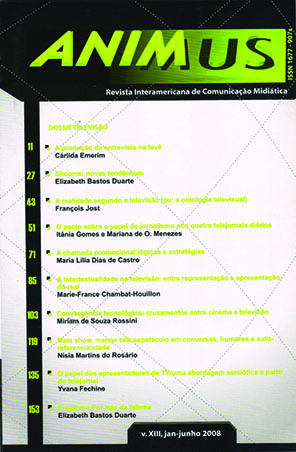A realidade segundo a televisão (ou: a ontologia televisual)
DOI:
https://doi.org/10.5902/2175497790462Parole chiave:
Construção de sentido, Realidade, Mundos televisuaisAbstract
O artigo atenta para o fato que a construção de sentido em televisão começa bem antes da difusão das imagens, no momento em que as emissoras promovem seus programas através de chamadas, de publicidades e de intervenções na mídia em geral. Nesse caso, a difusão da expressão tele-realidade pela imprensa incitou o público a assistir ao Loft story, como um testemunho sobre nosso mundo. O sucesso dessa etiqueta atesta também a existência de uma parte do público que aceita mais ou menos, ou, que, em todo o caso, não se recusa a ancorar esses programas ao mundo real. A questão não é aqui determinar se esse grupo de crédulos (aqueles que crêem na promessa da emissora) têm ou não razão, mas acordar sobre qual concepção de realidade se fala para ver esses programas como reenviando à realidade.
Downloads
Riferimenti bibliografici
ARMHEIM, Rudolf [1935]. Prospectives pour la télévision. Paris: L'Arche, 1986.
BOORSTIN, Daniel. The image: a guide to pseudo events in America. New York: Harper & Row: 1964.
GOFFMANN, Erving. Les rites d'interaction. Paris: Minuit, 1974
##submission.downloads##
Pubblicato
Come citare
Fascicolo
Sezione
Licenza
Copyright (c) 2024 Animus. Revista Interamericana de Comunicação Midiática

Questo lavoro è fornito con la licenza Creative Commons Attribuzione - Non commerciale - Condividi allo stesso modo 4.0 Internazionale.
Os autores de textos aprovados pelos pareceristas de Animus - Revista Interamericana de Comunicação Midiática cedem automaticamente, e sem qualquer tipo de ônus, o direito à primeira publicação do material submetido.







